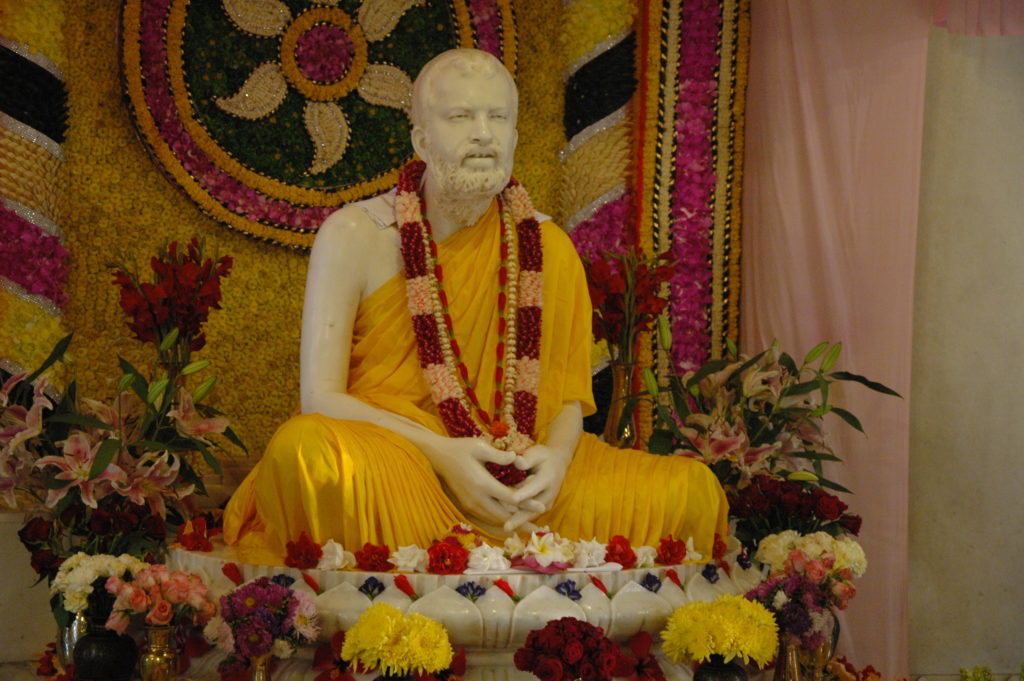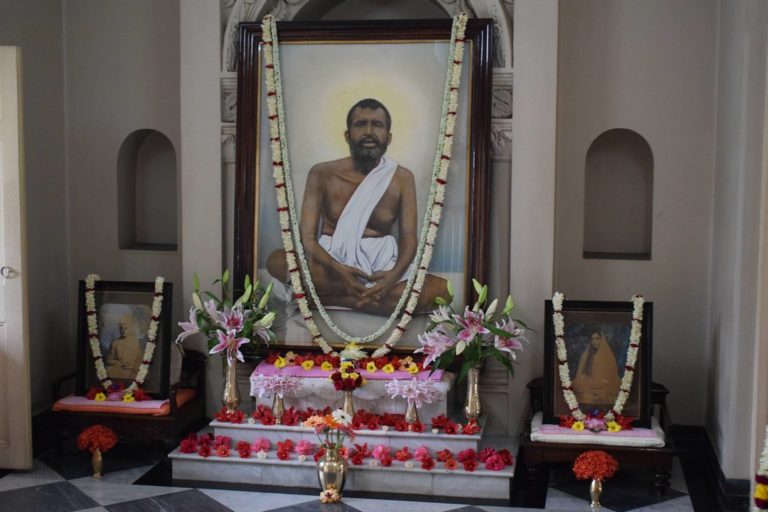Sri Ramakrishna visited numerous places in the city of Kolkata. Many of them are now teertha kshetras for thousands of devotees. Beginning with this article we will explore these places sanctified by his foot-dust.
Introduction
Sri Ramakrishna first arrived in Kolkata in 1853 at the behest of his elder brother to assist him in starting a Sanskrit tol school. From 1853 to 1886, apart from intermittent visits to Kamarpukur and other places of pilgrimage, he remained in the Kolkata city (earlier spelt as Calcutta) his whole life. During this period, he visited over 100 places in the Kolkata. These places can be grouped into 6 categories: 1) places celebrating festivals of various Hindu religious denominations, including different branches of the Brahmo Samaj and other denominations like Vaishnava or Tantric sects; 2) diverse non-Hindu places of worship including churches and mosques; 3) various temples of Mother Kali and other aspects of the Divine Mother; 4) numerous places associated with Sri Chaitanya Mahaprabhu; 5) residences and institutions of prominent personalities like Ishvarchandra Vidyasagar, Bhagavan Das, Keshab Chandra Sen, and other Brahmo devotees, etc.; 6) residences of devotees who had intense bhakti, or hosted religious festivals, pujas, etc.
In the next few issues, we will explore in detail these and other hidden or lesser known places sanctified by Sri Ramakrishna.
We can begin with a fundamental question: Even though scriptures claim that visiting holy places associated with saints can deeply transform one’s spiritual life, why does this transformation happen so rarely even for serious spiritual aspirants?
The answer is that we fail to follow Sri Ramakrishna’s systematic preparation and approach prior to, during, and after visiting places of pilgrimage. He not only preached these principles but practiced them in his own life. He repeatedly warned that merely visiting places of pilgrimage—or even witnessing his own spiritual ecstasies—was not sufficient to bring about transformation in spiritual life.
This article series focuses on Sri Ramakrishna’s teachings and the necessity for the pre-pilgrimage mindset. It will attempt to answer the questions: What do the scriptures say about the sanctifying power of teerthasthaanas or places of pilgrimage? What are Sri Ramakrishna’s warnings about visiting places of pilgrimage without cultivating a “spirit of bhakti?” How can we cultivate this spirit of bhakti? What are the kinds of external and internal distractions that we may encounter at the teerthas? And how will the spirit of bhakti help to overcome these distractions?
Scriptural support for pilgrimage
Sri Ramakrishna often eulogised the spiritual significance of teertha-sthaanas:
“Throughout the ages many monks, devotees, and perfected souls have visited sacred places to see God and call on Him wholeheartedly, shunning all other desires. That’s why there is a special manifestation of God in those places.”1 As the scriptures claim that God is allpervading (sarvavyaapi), then what is the necessity for visiting places of pilgrimage? Anticipating this argument, Sri Ramakrishna— in the very next sentence—provides a simple analogy (digging for water) to explain that though God exists everywhere, the spiritual aspirant need not put in much effort in teerthasthaanas: “God exists everywhere equally. If one digs deeply enough, one can find water in any place. But one does not need to dig for water where there is a well, a pool, a pond, or a lake. One can get water there at any time.”2
In the Srimad Bhagavatam Yudhishthira eulogises Vidura and describes how great souls enliven holy places:
भवद्-विधा भागवताः तीर्थ-भूताः स्वयं विभो 1
तीर्थी-कुर्वन्ति तीर्थानि स्वान्तःस्थेन गदाभृता॥॥ (1.13.10)
“O Great One! Lovers of God like you, having risen to the height of holiness, sanctify the holy places you visit, by bringing the presence of Narayana who resides in you.”
Swami Vivekananda further explains that “sages and holy persons, who have much of this sattva quality, can send it out and exert a tremendous influence day and night on their surroundings. A man may become so pure that his purity will become tangible. Whosoever comes in contact with him becomes pure.”3 Such is the case with the places visited by Sri Ramakrishna, Holy Mother, and Swamiji.
Even incarnations—such as Chaitanya Mahaprabhu, Sri Ramakrishna, and Sri Sarada Devi—were eager to visit places associated with previous incarnations as an opportunity to engage in the sadhana known as Leelaacintana. Chaitanya Mahaprabhu, along with his disciples, visited Vrindavan and revitalised it as a place of Krishna Bhakti. Similarly, Sri Ramakrishna visited places in West Bengal associated with Sri Chaitanya Mahaprabhu and sites in Vrindavan sanctified by the leelas of Sri Krishna. Sri Sarada Devi, spiritual consort of Sri Ramakrishna, too journeyed to Vrindavan to assuage her grief after her husband’s passing.
Nonetheless, Sri Ramakrishna repeatedly cautioned spiritual aspirants that merely visiting a holy place without devotion will not be spiritually beneficial: “Look, one who has it here (in the heart), has it there; one who has it not here, has it not there either….For one who is endowed with devotion, devotion increases with the influence of holy places. And as for one who does not have that, what can be derived?”4 This is further supported by the Sri Jaabaala Darshana Upanishad:
आत्मतीर्थ समुत्सृज्य बहिस्तीर्थानि यो व्रजेत्।
करस्थं स महारत्न त्यक्त्वा काचं विमार्गते॥ (4.50)
“One who, having forsaken the teertha of the Self, merely visits the external teertha is a person who, having forsaken the invaluable jewel in hand, goes in search of mere glass.”
In this regard, Sri Ramakrishna went to the extent of stating that “without this spirit of devotion,” witnessing his spiritual ecstasies will not bring much benefit. On 14 July 1885, Ratha Yatra was being celebrated at Balaram Bose’s house (a close householder devotee of Sri Ramakrishna). It was a day full of spiritual festivity and divine intoxication. Girish Ghosh had “brought with him a bespectacled friend” who had witnessed first-hand all of Sri Ramakrishna’s ecstatic moods amidst the singing and dancing of the joyous devotees. At the end of the day Girish’s friend remained unmoved and “quietly left the place without comment.” Sri Ramakrishna then said to Girish, “I say this to you and to everyone: Please do not force anybody to come here. Nothing happens except at the right time.”5 (emphasis added).
Why does Sri Ramakrishna place so much emphasis on cultivating a “spirit of devotion” prior to visiting places of pilgrimage?
Some spiritual aspirants may believe that their spirit of devotion is already sufficient, and that further preparation is not necessary prior to visiting places of pilgrimage. However, in the Gospel, Sri Ramakrishna emphasises that the spirit of devotion includes not only love of god but also vyakulata or spiritual yearning. He repeatedly says, “Nothing whatsoever is achieved in spiritual life without yearning.”6 He further emphasises that this yearning for the divine is not a fixed quantity and must be constantly intensified through prayer and other spiritual activities. In other words, whatever may be the spiritual aspirant’s level of bhakti, it must be given further momentum and a particular focus prior to embarking on pilgrimage or going to an isolated place for tapasya. For this reason, before visiting a place of pilgrimage Sri Ramakrishna would cultivate a “specific mood” (this will be discussed in a subsequent issue).
External and internal distractions in places of pilgrimage
One of the reasons why Sri Ramakrishna placed so much emphasis on cultivating a spirit of devotion prior to visiting teerthas is that there are many distractions—both external and internal—in places of pilgrimage which have the potential to hijack a spiritual aspirant’s mind and prevent him from utilising time in a proper way at the pilgrimage site. One of the common external distractions which pilgrims encounter is that they must devote an inordinate amount of energy and time planning and organising the minute details of the trip from start to finish, including the mode of transportation, lodging, clothes to carry, etc. Sometimes for weeks or even months together before the actual pilgrimage, pilgrims will direct all their energies into planning to the exclusion of everything else. Hence, when they finally leave and arrive at the holy place, their minds will remain occupied and active in this planning mindset. They will have difficulty turning off this planning mindset and thinking of spiritual things. Sri Ramakrishna often said, “If a man thinks of worldly things day and night, then his words are coloured by his thoughts.” Similarly, if a spiritual aspirant’s mind is constantly preoccupied with worldly thoughts prior to visiting holy places, then his/her mind will naturally drift toward mundane things even in a spiritual setting.
Nothing
whatsoever is
achieved in
spiritual life
without
yearning
Another external distraction is the common problem of encountering worldliness at pilgrim centres. For instance, pilgrims are often accosted by avaricious priests who will not allow them to have darshan in peace until they extract a large sum from them. Even an incarnation like Sri Ramakrishna acknowledged these external distractions in teerthas. During his visit to Varanasi in 1868, he was deeply anguished by Mathur Babu’s worldly mindset as well as the general preoccupation with “lust and greed” of the people there. Despite his spiritual experiences in Kashi, Thakur nearly regretted having visited Varanasi at all. Afterwards he lamented, “Mathur Babu had taken me with him on pilgrimage. We stayed for many days in Raja Babu’s house in Kashi. One day I was sitting with Mathur Babu in the drawing room. Raja Babu was also there with his men. I noticed that they were talking about worldly things: so much money was lost, and so on. I began to weep, ‘Mother, where have you brought me? I was so well off in Rani Rasmani’s temple. That I should hear of lust and greed even in holy places!’”7
Internal distractions: The dichotomous nature of the human mind
External distractions like lust and greed in teerthas become even more problematic because of the dichotomous nature of the human mind. The idea is that all human minds, including those of a spiritual aspirant, possess opposite tendencies (spiritual and mundane), and that environment dictates which samskaras are activated. Sri Aurobindo explains this in detail: “… everyone possesses in a large measure…two opposite tendencies of character, in almost equal proportions, which are like the light and the shadow of the same thing. Thus someone who has the capacity of being exceptionally generous will suddenly find an obstinate avarice rising up in his nature, the courageous man will be a coward in some part of his being and the good man will suddenly have wicked impulses. In this way life seems to endow everyone not only with the possibility of expressing an ideal, but also with contrary elements representing in a concrete manner the battle he has to wage and the victory he has to win for the realisation to become possible.”8
An interesting example of the emergence of “two opposite tendencies in almost equal proportions” in places of pilgrimage is found in the life of Mathur Babu during his visit to Varanasi with Sri Ramakrishna. As we have already mentioned, Sri Ramakrishna lamented Mathur Babu’s worldly talk in Kashi. On the other hand, Sri Ramakrishna praised Mathur Babu’s wonderful generosity during the same trip. He recalled, “Mathur spent more than 1,00,000 rupees on the pilgrimage to Varanasi. After arriving at Varanasi, Mathur arranged a feast for the local brahmin pandits; [on] another day he invited their entire families, fed them sumptuously, and gave a cloth and a rupee to each one of them.”9
Unfortunately, since Sri Ramakrishna’s visit to Kashi more than 150 years ago, the external obstacles at teerthas have multiplied. In addition to money-minded priests, worldly-minded tourists, and travel companions with varying temperaments, there are now modern distractions such as mobile devices and internet. These technologies further prevent spiritual aspirants from going inward and upward. In her book Rapt, Winfred Gallagher accurately describes the explosion of external stimuli in the 21st century internet age: “At any one moment, your world contains too much information, whether objects, subjects, or both, for your brain to represent, or depict clearly for you. Your attentional system selects a certain chunk of what’s there, which gets valuable cerebral real estate and, therefore, the chance to affect your behavior. Moreover, this thin slice of life becomes part of your reality, and the rest is consigned to the shadows or oblivion.”(italics added)10
To counter these external and internal distractions and make a spiritual pilgrimage as fruitful as possible, Sri Ramakrishna teaches that three mindsets must be cultivated prior to, during, and after completion of the pilgrimage: 1) the pre-pilgrimage mindset, 2) the pilgrimage mindset, and 3) post-pilgrimage mindset. This three-fold methodology will be discussed in subsequent issues.
(To be continued)
References
1) Sri Ramakrishna and His Divine Play. [hereafter Divine Play] Swami Chetanananda. p. 605
2) Ibid.
3) The Complete Works of Swami Vivekananda. 1:252
4) Divine Play. p.606
5) The Gospel of Sri Ramakrishna. p. 809
6) Gospel, p. 86
7) Divine Play. p.119
8) Integral Education. Sri Aurobindo
9) Divine Play. p.608
10) Rapt, p. 9
Source : Vedanta Kesari, January, 2020



